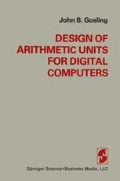Abstract
Multiplication is usually regarded as the second most important arithmetic function. However, statistics suggest that in some large scientific programs it occurs as frequently as addition and subtraction combined. As in the previous chapter, this chapter will discuss the procedures involved in multiplication of two binary ‘bit patterns’, and will not discuss the problems of handling signed numbers. Signed multiplication will be described in chapter 4 in the discussion of the representation of negative numbers.
Access this chapter
Tax calculation will be finalised at checkout
Purchases are for personal use only
Preview
Unable to display preview. Download preview PDF.
References
Booth, A. D., ‘A Signed Binary Multiplication Technique’, Q. Jl Mech. appl. Math., 4 (1951) 236–40.
Dadda, L., ‘Some Schemes for Parallel Multipliers’, Alta Freq., 34 (1965) 349–56.
Dean, K. J., ‘Design for a Full Multiplier’, Proc. I.E.E., 115 (1969) 1592–4.
This design, like many others on similar lines, is not fast, and is very expensive. de Mori, R., ‘Suggestion for an IC Fast Parallel Multiplier’, Electron. Lett, 5 (1969) 50–1. Yet another design which is not fast, and very expensive.
Gosling, J. B., ‘Design of Large High Speed Binary Multiplier Units’, Proc. I.E.E., 118 (1971) 499–505. First description, as such, of the twin-beat multiplier (termed serial—parallel here). Useful assessment of cost effectiveness of multipliers at that time. Relative figures are still relevant.
Gosling, J. B., Kinniment, D. J., and Edwards, D. B. G., ‘Uncommitted Logic Array Provides Cost Effective Multiplication even for Long Words’, Comput. dig. Tech., 2 (1979) 113–20.
Guild, H. H., ‘Fully Iterative Fast Array for Binary Multiplication and Addition’, Electron. Lett, 5 (1969) 263. Another design which is not fast, and very expensive.
Habibi, A., ‘Fast Multipliers’, I.E.E.E. Trans. Comput, 19 (1970) 153–7.
Kilburn, T., Edwards, D. B. G., and Thomas, G. E., ‘The Manchester Mk II Digital Computing Machine’, Proc. I.E.E., 107B Suppl. 2 (1956) 247–68. An early paper describing a carry-save-adder multiplier, though not by that name.
Thornton, J. E., Design of a Computer: CDC 6600 (Scott Foresman, Glenview, Ill, 1970).
Wallace, C. S., ‘A Suggestion for a Fast Multiplier’, I.E.E.E. Trans. electronic Comput, 13 (1964) 14–17. A simultaneous multiplier with carry-save adders.
Author information
Authors and Affiliations
Rights and permissions
Copyright information
© 1980 John B. Gosling
About this chapter
Cite this chapter
Gosling, J.B. (1980). Multiplication. In: Design of Arithmetic Units for Digital Computers. Springer, New York, NY. https://doi.org/10.1007/978-1-4757-4938-0_3
Download citation
DOI: https://doi.org/10.1007/978-1-4757-4938-0_3
Publisher Name: Springer, New York, NY
Print ISBN: 978-1-4757-4940-3
Online ISBN: 978-1-4757-4938-0
eBook Packages: Springer Book Archive

